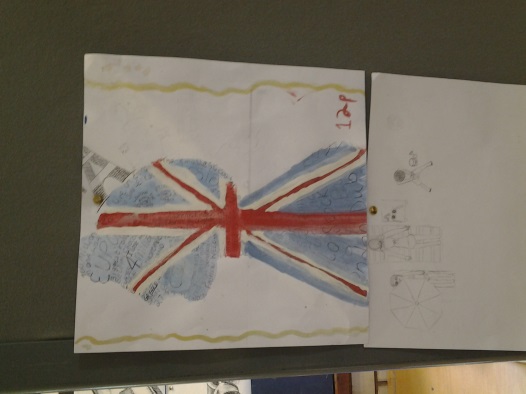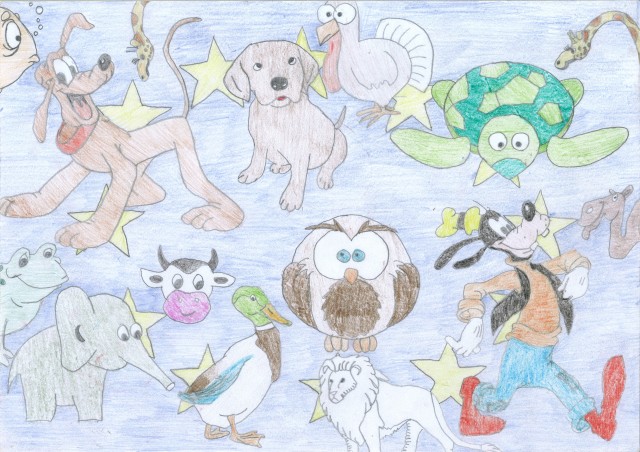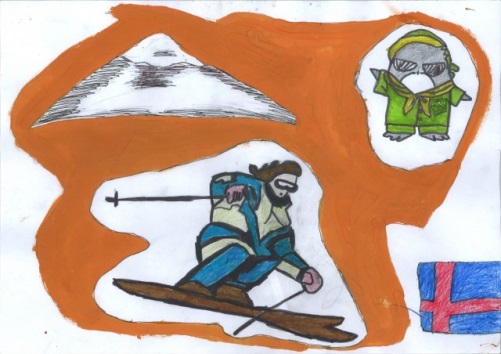Chenderit School (secondary) - United Kingdom
Region: Northamptonshire
Other schools in the Quad Blog: Institut Torras I Bages (Spain), Muurolan Peruskoulu (Finland), Jesus and Mary Secondary School Gortnor Abbey (Ireland)
Creative Connections Project: Being European
Background
This case study describes the research carried out in one of the two English secondary schools. Chenderit is a state-maintained secondary school (pupils aged 11-18) in a rural part of Northamptonshire. Chenderit School was designated as a specialist Visual Arts College from September 2002 and has a public art gallery with a programme of events which includes both professional artists and the work of pupils at the school. As might be expected, the art departments are extensive and pupils can engage with a broad range of art media using a wide range of materials. There is a large 3D/ceramics workshop, printing equipment and open plan studios in which the pupils work. The staff have a well-stocked room with large range of books, resources and themed lesson packs for working on ideas/artists etc. The art ethos is strong and encapsulated in the school’s vision as:
We feel that through understanding, creating, making and evaluation, the student acquires more highly-developed discrimination and judgement.
The department has a lively atmosphere and this is largely due to the enthusiasm of the staff team (currently comprising six experienced teachers.)
Chenderit has a wide catchment area and was opened to accommodate children from the villages in this region of the country. It accepts all children regardless of ability if they are within the catchment area. The school population is not culturally diverse and a large majority of students are of a White British background. Very few students have a first language other than English. The proportion of students known to be eligible for free school meals is low. The proportion of students with special educational needs and/or disabilities is below average, although the proportion with a statement of special educational needs is a little above the national average.
The Creative Connections team at the school comprised of two teachers both of whom were secondary art specialists. The external researcher shared ideas for developing lessons (both through a training day and then via emails and school visits in the following months.) The teachers agreed to use one lesson per week (of approximately one hour) for this project; the aim being to start in January 2013 and continue through to May 2013. The pupils were in two classes (24 per class) – both groups were mixed ability groups – Group A had three students (all boys) with SEN statements (2 with low reading ages and another with chronic behavioural problems) and Group B contained a group of five boys with very challenging behaviour. The teachers’ expectations were initially very positive about the project but sceptical that their students had any real perceptions of a European Identity.
Aims and Framework
The two teachers attended the training day at Roehampton in November 2012 and both agreed that they would devise a project to explore the theme of ‘Being European’ – they were given the Images & Identity materials (available on the Creative Connections website) as stimuli and also told they could evolve their own materials to explore European Identity too. They explored ideas about: Belonging, Identity and Membership. Both teachers had agreed that their pupils’ work would be underpinned by questioning: they sought to develop their pupils’ questioning skills and challenged them to keep developing their ideas by asking each other to explain their work. Once all secondary questions had been exhausted, pupils had a default question: “Can you tell me more about this?” Both teachers found that this approach generally worked well.
In addition, the teachers agreed that they would use contemporary artists – particularly those whose work focuses on identity – in order to promote debates about how art expresses particular themes or ideas. Both teachers knew that the majority of their students were resistant to engaging with contemporary art and therefore they hoped to be able to use the Creative Connections project to promote further engagement by developing the cultural links facilitated by the project.
The teacher leading Group A did not use the Images &Identity schemes of work but worked with what he described as a more “open-ended and less structured” approach led by the pupils’ interests and ideas. Group B was more structured overall with the teacher creating weekly lesson plans and setting pupils particular tasks, but he did admit there was more “freedom” for pupils to develop their work in different ways. Only teacher B wrote the reflective diary recording his time on the project.
The Study
The research took place over eight weeks in single hourly sessions each week with teachers providing homework tasks when appropriate. The two groups were taught on different days and at different times (one morning and one afternoon). Both teachers work closely most days so were able to discuss their work and progress on a regular basis. Permission was obtained to observe pupils working, to photograph them working and to use images of their artwork for research purposes.
This research was grounded in action research theory but the model was adapted by the teachers to work within the boundaries of their practice. The most significant element of the research was the reciprocal relationship between the teachers and their pupils. In England, the National Curriculum is highly structured and teachers have little freedom to adapt content or give pupils the space to truly explore ideas. However, the core aim of Creative Connections was to promote the “pupil voice,” therefore the intention of the project was for the teachers to guide pupils but allow them to take creative risks, to challenge (and be challenged) and to be active participants in the research process.
The focus on questioning is very important to this study as it allows pupils time and space to explore ideas in some depth. In addition, they can acknowledge the complexity of an issue such as European Identity and examine each other’s points of view. The teachers encouraged pupils to talk whilst they worked and as issues or ideas began to develop, so the teachers responded reflexively by showing pupils other artwork, offering them additional media and supporting experimental approaches.
Research in Action
Initial sessions for both groups focused upon the purpose of the project and getting pupils to think about the issue of identity and belonging. Both teachers were looking for stereotyping, and for any other misconceptions regarding Europe in particular. Discussions and group activities revealed some trends, for example Sweden was associated with IKEA and this led to further consumer links; Ireland led to a discussion about accents and then concern about the IRA. Geographical themes emerged, particularly pupils’ poor grasp of European countries – one asked if Japan was in Europe. These early lessons also included discussions about EU membership and again, some pupils demonstrated very poor understanding of their connection to this, but for others particular issues arose as Teacher A explained:
The most interesting discussion which took place today was the person who had a Polish window cleaner. Suddenly everybody seemed to know quite a lot about immigration.
As immigration has been a national ‘issue’ in 2013 in England, it is useful to see how pupils interpreted the public discussions and made connections with them.
As the weeks progressed, the teachers moved the pupils forward by asking them to collect images that represented Europe and to begin to “map” out a personal “connection” with Europe which they could explore in a visual way. This proved more difficult than anticipated – both groups progress was hampered by school closure and several events which meant Creative Connections focused lessons were taken off the timetable. Both teachers found that a break of some two weeks left pupils confused about the project and its aims.
In the latter half of the research phase, both teachers used different stimuli to encourage pupils to produce artwork. Group A focused on creating a series of images which redeveloping each iteration to reveal differences (see for example – the Queen’s Head).


Version 1 has a nationalistic underpinning – the queen’s head is represented within the framework of a postage stamp, but the concession to another Europe is her headgear – the Eiffel Tower.
In Version 2, the student began to develop the work further. She examined European geography and included (influenced by Wordle) names of European capitals cities, countries and distinctive foods together with some symbolic imagery – flags and Olympic rings.
Overall the pupils engaged with the project and the teacher admitted that his primary focus was always on the artwork, but he engaged pupils in dialogue about being European and what they thought about Europe as a part of the art creation process. He noted that:
I wouldn’t have known about pupils’ lives, other things they do and enjoy – everyone had a story to tell about their connections with Europe.
“Being” European
The level of understanding of pupils in Group A regarding being European or having a European identity was very weak; pupils only seemed to know or engage with Europe at a superficial level and relied on localised experiences such as European brands (cars, chocolate, clothing), visits to Disneyland, or food that they liked to eat. Molly’s work is an example of this yet her statement of explanation does not ‘fit’ with the imagery.
Concern for Conservation; My art work is about animals in the EU and I have added the EU flag in the background

In Group B, the pupils had broad ranging attitudes to Europe, some with family links to particular countries, discussed these, but others (three pupils in particular) expressed open hostility to Europe and things they perceived as non-British; the rest of the group did not express any preference regarding a European identity. Both teachers felt that even at the end of the project, the majority of pupils still found it hard to engage with a sense of identity beyond that of the personal, local sense of the self. Although some pockets of curiosity were evident as for example, Tobey explained:
I have done my drawing because it is to do with a country in Europe- Iceland. I have done Iceland because Iceland is a little island that that is quite far away from the EU so people need to know about it.

The teacher noted that Tobey had developed a particular interest in why Iceland was not a part of the EU and questioned why it was not. He had not visited Iceland, but seemed concerned about its isolation as an island nation.
Pupils in Group A were encouraged to talk as they worked and to share thoughts and ideas about Europe in an informal way and their teacher felt that this was usually a successful way of generating debates. However, both teachers expressed dismay that many pupils did not move forward in their thinking but were also realistic in acknowledging that working over such a short time span together with numerous events which affected the continuity of their teaching. Both of the teachers had strong connections with Europe and a sense of European identity; they found it difficult to reconcile the feelings of students and the core focus on what the perceived to be consumer-driven themes which pupils identified as ‘European’.
Reflections
The project has made both teachers look at their pupils in different ways; Teacher A noted that he had always thought of his pupils as privileged, but realised that some of them did not engage with culture in the sense that their discussions about travel were motivated by consumption and very little immersion within other cultures to the extent that this could change ideas or aspirations. He noted that students do not engage in exchanges with others as they did in the past and their opportunities to visit other European countries are in one sense broader, but also perhaps less rich. Teacher B enjoyed the chance to find out more about his pupils and their connections to Europe/other countries; he found this comforting and explained to them that his wife was French and he was a pro-European. However, he was surprised at the level of hostility from pupils in relation to other European nations.
Both teachers felt that pupils enjoyed the online interactions (when they came) from other pupils in other countries. But they wished that they could have faster responses and more responses overall. The self-motivation of pupils impressed Teacher B and he felt that the more able pupils in his group surpassed his expectations. In addition, Teacher B felt that having to develop a flexible approach to teaching had taught him a lot about being less restrictive in his teaching and to explore the possibility of giving pupils more freedom. Teacher A felt that in his group, the project had opened up some further understanding of pupils in other countries and had made pupils question/discuss issues of the day, e.g. the global recession and holidays.
IT access was limited in Chenderit; the art rooms are not equipped with a computer/projector or screen so presenting pupils with the Image Bank for example was not possible. The quality of online interactions was very limited overall; both teachers had worked hard to generate discussion and a flow of ideas with pupils, but the reality of posting and then writing further blog messages was weak. There were very limited opportunities for pupils to go online and upload their work so in this school it ended up being the teachers who uploaded work for all of the pupils (not what we had planned in the project). Despite pupils having individual log in addresses, their interaction with the website was not what the teachers had hoped and pupils had to be told to log in; something which they considered a ‘chore’ or a ‘problem’. Teacher B had two focused lessons in the IT suite and was able to let pupils log on and interact, but Teacher A did not organise any IT suite time; it was not possible due to his timetable.
Teacher B kept a weekly lesson diary and in this he notes (from week 1) the poor behaviour of one group of boys in his class. His frustration was palpable as his attempts to engage them were unsuccessful and he spent a great deal of time in the classroom dealing with their behaviour at the expense of working with other pupils. Overall, he felt that the work which was the culmination of the project did not truly reflect the skills of the pupils. Teacher A concurred and explained that it was poor skills development which ‘saddened’ him when he looked at the final pieces of work.
One incident of note related to a controversial posting by a Spanish pupil this included a link to some Spanish contemporary art (a video/collage installation which explored relationships); the hostility shown towards this work led to a heated discussion on the blogs (between UK pupils) and involvement of the school’s Senior Management Team. The Project Director was telephoned and asked to take the link down so that pupils were not offended by it. It is important to note that the complaints came from the pupils rather than from the teachers. Both teachers felt that this was a reflection upon the insular nature of their pupils and it explained their narrow attitudes to identity.
Teacher B summed up the project as one of challenge and change; he felt that he had become a facilitator rather than a teacher and that this took him out of his usual comfort zone and meant he used a broader range of materials and sources. His approach to the project was student-led and this was problematic for him; he felt that this championed creativity but also meant that pupils who were less able tended to lack any willingness to do anything beyond the very basic. He described students as being ‘at sea’ in having so much freedom in the process of developing this project.
It appears that the promotion of pupil voice and the ambition to put the pupils at the centre of this project was initially seen as a challenge in this English secondary school but soon became a ‘problem’. The goal of enhancing notions of identity and belonging was successful within tight boundaries, but as with the outcomes of the Maltese schools in the Images and Identity project, pupils’ abilities to move beyond the local were limited by reluctance and a genuine lack of engagement in the idea that Europe could be relevant to them.


